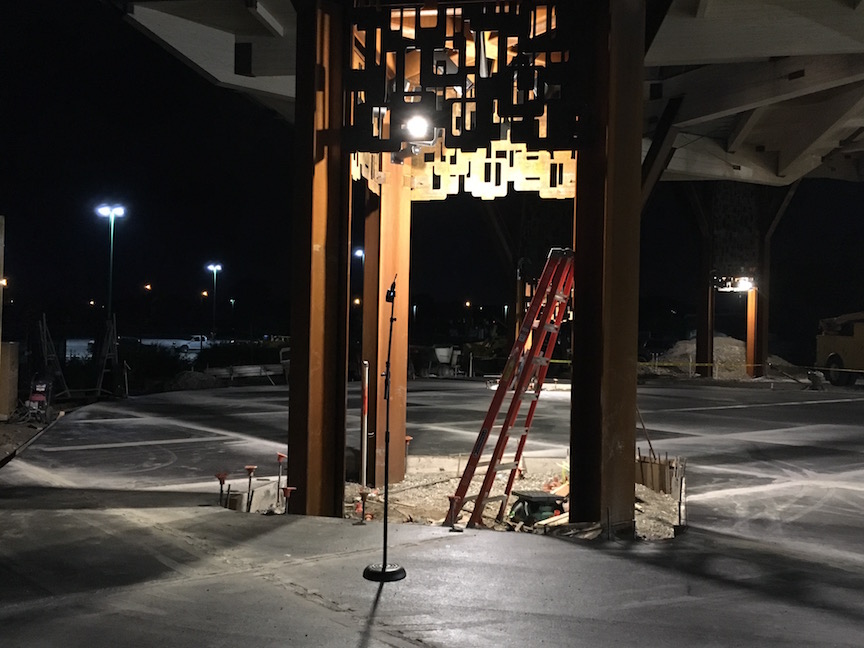 I just got back from a second trip out of state to help finish up a new sound system installation at a zoo. The sound system consists of multiple JBL CBT 100LA speakers. For aesthetic reasons, the speakers are mounted inside what the architect calls pods and are blocked by decorative metalwork. Another interesting decision is using the center of each pod as a drain for water that collects on each pod’s roof. These speakers are literally located inside the equivalent of a rain gutter.
I just got back from a second trip out of state to help finish up a new sound system installation at a zoo. The sound system consists of multiple JBL CBT 100LA speakers. For aesthetic reasons, the speakers are mounted inside what the architect calls pods and are blocked by decorative metalwork. Another interesting decision is using the center of each pod as a drain for water that collects on each pod’s roof. These speakers are literally located inside the equivalent of a rain gutter.

Regarding outdoor use, JBL CTB 100LA documentation states the following:
“Butyl rubber surrounds provide long life even in high humidity environments”
“CBT 100LA can be installed either indoors or outdoors. The drivers are weather-treated, the fiberglass reinforced ABS cabinet is excellent for outdoor applications, external screws are stainless steel screws, and the painted aluminum grille resists rusting in the harshest conditions.”
“IP-55 rated, per IEC529, when installed with optional MTC-PC2 panel cover. UV, moisture and 200-hr ASTM G85 acid-air/salt-spray resistant”
wiki – IP Code
Regarding IP ratings, “The first digit indicates the level of protection that the enclosure provides against access to hazardous parts (e.g., electrical conductors, moving parts) and the ingress of solid foreign objects. The second digit indicates the level of protection that the enclosure provides against harmful ingress of water.”
So an IP rating of 55 equals:
5- Ingress of dust is not entirely prevented, but it must not enter in sufficient quantity to interfere with the satisfactory operation of the equipment.
5 – Water projected by a nozzle (6.3 mm) against enclosure from any direction shall have no harmful effects.
Being rated for outdoor use means that the cabinet / drivers shouldn’t fail when exposed to the weather but does that mean that the speaker’s frequency response is unaffected when wet? Fortunately, I was able to measured before and after the storm. The BROWN trace is the DRY response. The BLUE trace is the WET response.
 Obviously there is a noticeable reduction in high frequencies when the speaker grills are filled with water. Without knowing this, I might mistakenly boost the missing high frequencies only to have too much once the grills dry out again. The moral of this story is that we should expect the HF response of our outdoor speakers to be affected by water if there are grills &/or foam involved. In this case, the intelligibility of human speech is mostly lost while the speaker grills are soaked. Solution? One option is to relocate the speakers outside of the pods. I doubt the architect is going to appreciate this suggestion. Another option may be to simply remove the grills which shouldn’t be a big deal. Yet another option may be to clear the water using some sort of audio tone or noise. I will be doing some experimentation to see how successful we might be in using pink noise or low frequency sweeps for “water abatement”. If it works, I’ll do another post with those details.
Obviously there is a noticeable reduction in high frequencies when the speaker grills are filled with water. Without knowing this, I might mistakenly boost the missing high frequencies only to have too much once the grills dry out again. The moral of this story is that we should expect the HF response of our outdoor speakers to be affected by water if there are grills &/or foam involved. In this case, the intelligibility of human speech is mostly lost while the speaker grills are soaked. Solution? One option is to relocate the speakers outside of the pods. I doubt the architect is going to appreciate this suggestion. Another option may be to simply remove the grills which shouldn’t be a big deal. Yet another option may be to clear the water using some sort of audio tone or noise. I will be doing some experimentation to see how successful we might be in using pink noise or low frequency sweeps for “water abatement”. If it works, I’ll do another post with those details.
JBL CBT100LA – spec sheet PDF
JBL CBT100LA – webpage
JBL CBT100LA – FAQ PDF
JBL CBT100LA – tech notes PDF
JBL CBT100LA – Quick Start Guide PDF
JBL – CBT Calculator

